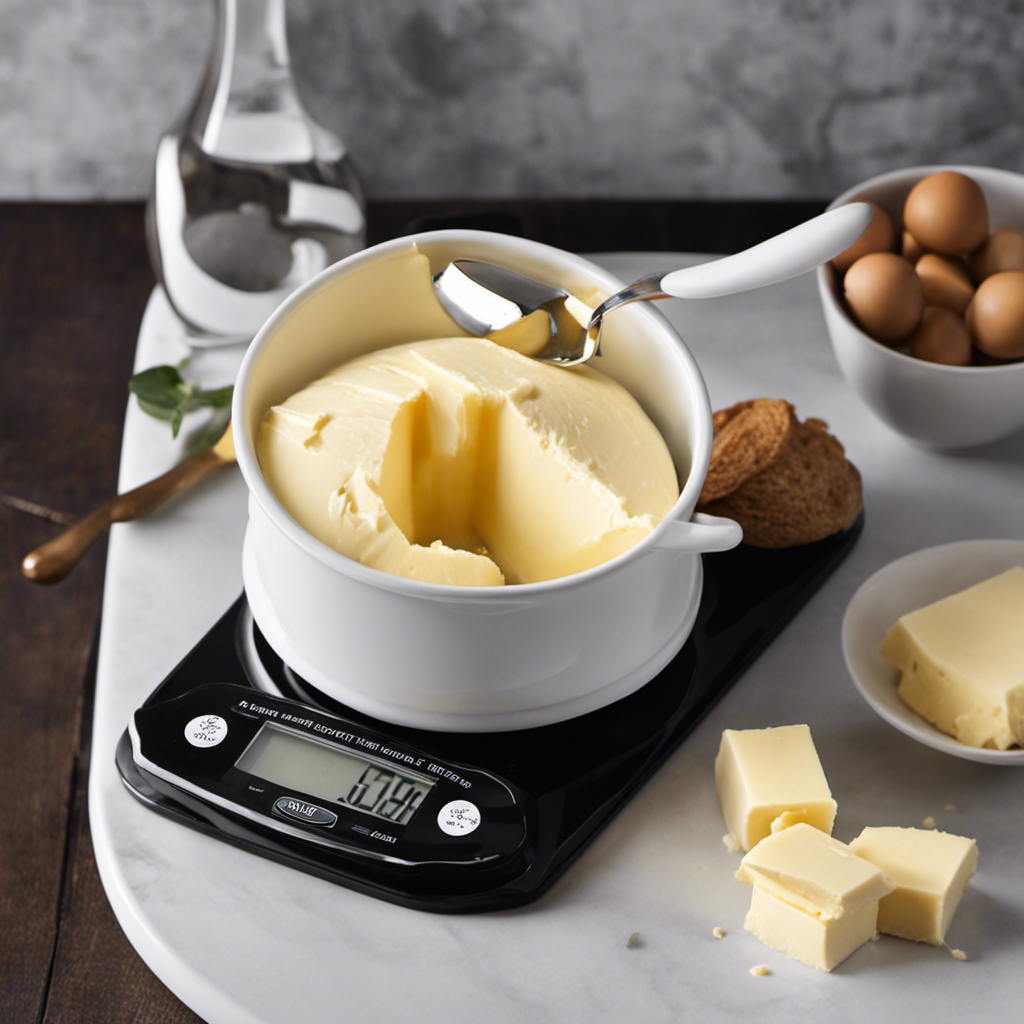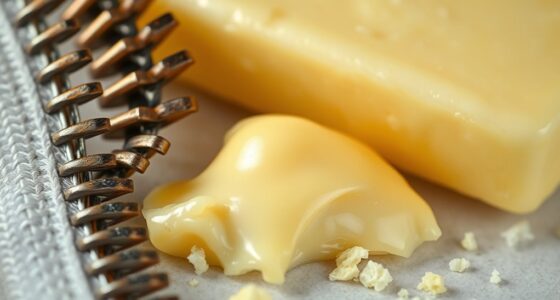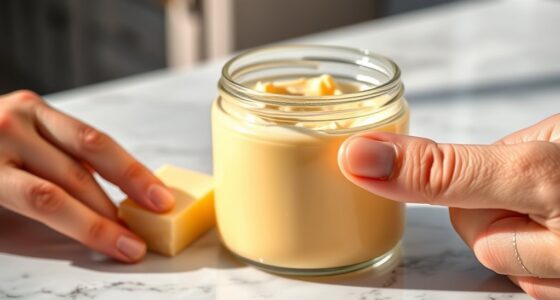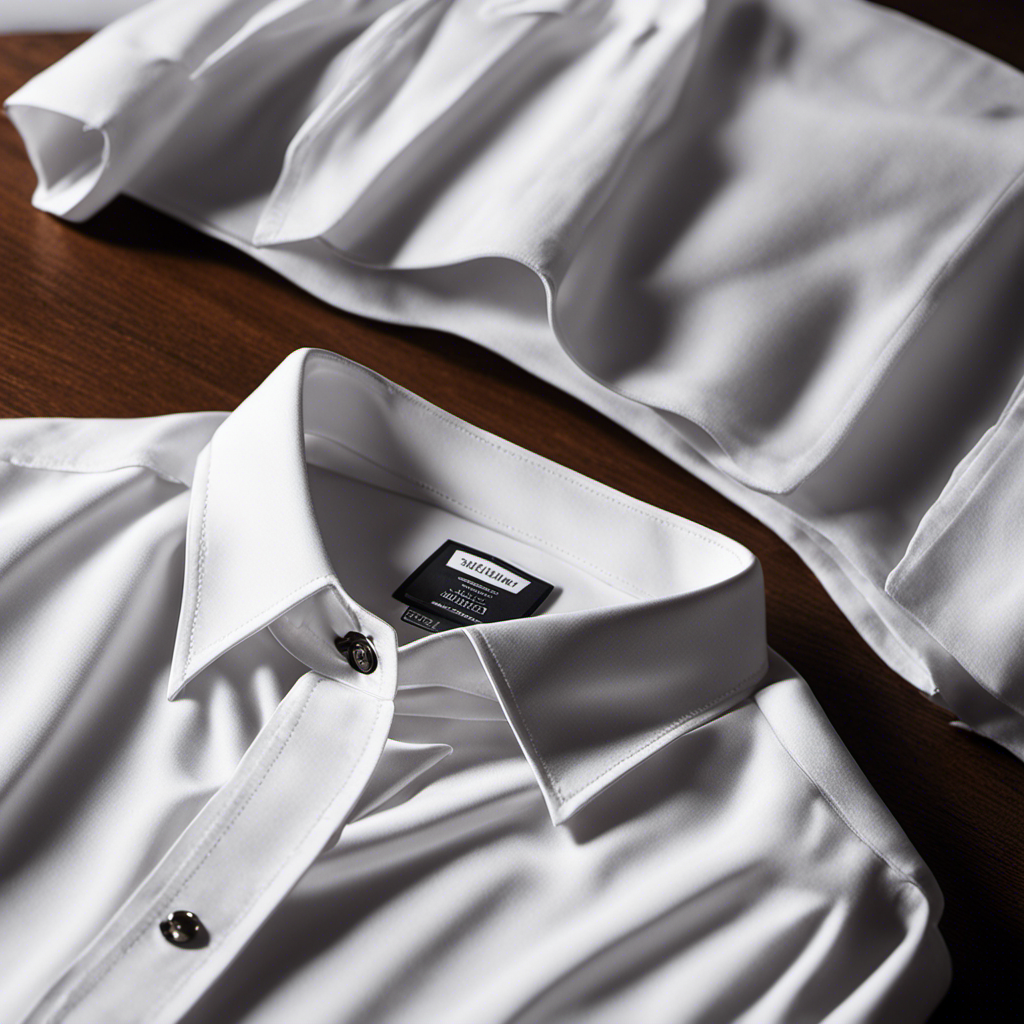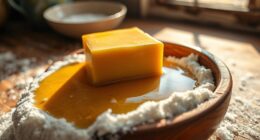I have always found it challenging to measure butter from a tub. It can be annoying when a recipe requires a precise amount, and you are left to estimate how much to use.
But fear not! In this article, I’ll guide you through the process of measuring butter in a tub with precision and ease.
From understanding the measurement units to utilizing the right tools, I’ll share tips and tricks to ensure your butter measurements are spot on every time.
Key Takeaways
- Precise measurements are crucial for baking and cooking.
- Using a kitchen scale provides the most precise measurement.
- Reading the packaging for tablespoon or cup equivalents can help measure butter without a scale.
- Converting from sticks to cups or tablespoons ensures accurate measurements in recipes.
Understanding the Measurement Units
To understand the measurement units, you’ll need to familiarize yourself with tablespoons and cups. When it comes to measuring butter, it’s important to know the equivalents. One stick of butter is equal to 8 tablespoons or 1/2 cup. This knowledge will help you accurately measure the amount of butter needed for your recipe.
It’s also crucial to understand butter density. Butter can vary in density depending on its temperature and brand. Softened butter is denser than cold butter, so when measuring, it’s best to pack it tightly into the measuring cup or spoon. This ensures that you’re getting the right amount of butter for your recipe.
Now that you understand the measurement units and butter density, let’s move on to the tools required for measuring butter.
Tools Required for Measuring Butter
When it comes to measuring ingredients like butter, having the right tools is crucial. Two common options for measuring butter are a measuring spoon or a scale.
Using a measuring spoon can be convenient and easy, but using a scale ensures more accurate measurements.
However, if you don’t have access to these measuring tools, there are some substitutes you can use to still achieve accurate measurements.
Measuring Spoon or Scale
You can use a measuring spoon or a scale to accurately measure butter in a tub.
When it comes to understanding different measurements, a measuring spoon is a common choice. It allows you to scoop out the desired amount of butter, whether it’s a teaspoon or a tablespoon.
However, using a scale has its own benefits. A scale provides a more precise measurement as it allows you to weigh the butter in grams or ounces. This is especially useful when following a recipe that requires an exact amount of butter.
Additionally, using a scale eliminates the need for multiple measuring spoons, making it a more efficient and convenient option.
Accurate Measurements Guarantee
Using either a measuring spoon or a scale guarantees precise measurements for your recipes. When it comes to butter, accurate measurements are crucial to achieve the desired texture and taste in your baked goods.
Here are four reasons why precise butter measurement techniques are important:
-
Consistency: By measuring butter accurately, you ensure that each batch of your recipe turns out the same, creating a consistent and reliable outcome every time.
-
Texture: Butter contributes to the texture of your baked goods. Precise measurements ensure that the right amount of fat is incorporated, resulting in tender and moist treats.
-
Flavor: Too much or too little butter can affect the flavor of your recipe. Precise measurements help maintain the perfect balance, enhancing the overall taste of your dish.
-
Baking Science: Baking is a science, and precise measurements are essential to achieve the desired chemical reactions and reactions between ingredients. Accurate butter measurement techniques play a crucial role in the successful execution of your recipes.
Substitutes for Measuring Tools
If you’re in a pinch and don’t have access to traditional measuring tools, there are substitutes you can use to accurately measure ingredients.
When it comes to measuring butter, there are a few alternative methods you can try. One simple substitute is using the markings on the butter wrapper itself. Most butter wrappers have tablespoon and cup measurements printed on them, making it easy to measure out the desired amount.
Another option is using a kitchen scale. Simply weigh the butter and convert the weight to tablespoons or cups using a conversion chart.
Additionally, you can use a tablespoon as a makeshift measuring tool. One tablespoon is equal to about 14 grams of butter, so you can estimate the amount based on that.
With these alternative measuring methods, you can accurately measure butter even without traditional measuring tools.
Measuring Butter by Weight
To measure butter by weight, it’s important to use a kitchen scale. Using a scale ensures accuracy and consistency in your recipes. Here are four reasons why weighing butter is beneficial:
-
Precise Measurements: By weighing butter, you can achieve precise measurements, resulting in more accurate and consistent recipe outcomes.
-
Easy Conversion: Weighing butter allows for easy conversion between different units of measurement. You can easily convert grams to ounces or vice versa.
-
Consistency in Baking: Baking is a science, and precise measurements are crucial for consistent results. Weighing butter helps maintain the desired texture and taste in your baked goods.
-
Less Mess: Unlike measuring butter by volume, using a kitchen scale eliminates the need for scraping butter into measuring cups, reducing mess and ensuring you have the exact amount needed.
Now, let’s explore another method of measuring butter: measuring by volume.
Measuring Butter by Volume
When measuring butter by volume, it’s important to consider the texture and shape of the butter. Understanding butter density is crucial for accurate measurements. Butter can have varying densities depending on its temperature and how it has been stored.
To convert volume to weight, it’s helpful to know that one tablespoon of butter weighs approximately 14 grams. So, if a recipe calls for ½ cup of butter, which is equivalent to 8 tablespoons, you can calculate that it weighs around 112 grams. However, it’s always best to use a kitchen scale for precise measurements.
Tips for Measuring Butter in a Tub
Accurate butter portioning is crucial for precise baking and cooking. In this discussion, I will explore alternative measuring methods to help ensure accurate butter portioning.
Accurate Butter Portioning
You can easily measure butter in a tub by using a kitchen scale. This allows for accurate portioning and eliminates the need for estimating.
Here are four reasons why measuring butter equivalents is essential:
-
Precision: Measuring butter with a scale ensures precise amounts for your recipes, resulting in consistent and delicious outcomes.
-
Consistency: By using accurate measurements, you can achieve the same taste and texture every time you prepare a dish that requires butter.
-
Control: Measuring butter allows you to have better control over the fat content in your recipes, which is crucial for those watching their dietary intake.
-
Professional results: When you measure butter accurately, your baked goods will turn out just like those from a professional bakery, impressing family and friends alike.
Alternative Measuring Methods
If you’re looking for different ways to gauge the amount of butter, consider using alternative measuring methods.
When it comes to portioning butter, there are a few creative techniques you can try.
One method is using a kitchen scale to weigh the butter. Simply place a bowl on the scale, tare it to zero, and then add the desired amount of butter.
Another option is using a butter cutter or slicer. These tools have markings to help you measure the butter precisely.
Additionally, you can use a butter mold or ice cube tray to portion the butter into individual servings. This is especially helpful if you need to measure smaller amounts for baking or cooking.
These alternative measuring techniques can make it easier to measure the perfect amount of butter for your recipes.
Converting Butter Measurements
Converting butter measurements can be tricky when trying to measure it in a tub. It’s important to understand butter equivalents and how to convert butter ratios accurately. Here are four key points to consider:
-
Use a kitchen scale: Weighing the butter will provide the most precise measurement, especially when dealing with recipes that require specific amounts.
-
Read the packaging: Many butter tubs have markings indicating tablespoon or cup equivalents. This can be helpful when trying to measure without a scale.
-
Convert from sticks: If a recipe calls for butter in sticks and you only have a tub, remember that one stick is equal to ½ cup or 8 tablespoons.
-
Adjust for different butter fat percentages: Some recipes may require unsalted butter, while others call for salted butter. Be sure to adjust the measurements accordingly.
Frequently Asked Questions
Can I Use a Regular Kitchen Scale to Measure Butter by Weight?
Yes, you can use a regular kitchen scale to measure butter by weight. It’s a precise method of converting volume to weight measurements. I recommend using a digital kitchen scale for accurate results.
How Do I Convert Tablespoons Into Grams When Measuring Butter by Volume?
Converting tablespoon measurements can be tricky when measuring butter by volume. However, there are alternative ways to measure butter, such as using a kitchen scale to weigh it in grams.
Is It Possible to Measure Butter in a Tub Using a Measuring Cup?
Yes, you can use a measuring spoon instead of a cup to measure butter in a tub. Alternatively, you can also use a kitchen scale to measure the weight of the butter.
Can I Use a Knife to Level off the Top of the Butter in the Tub for Accurate Measurements?
Using a knife to level off the top of the butter in the tub is a great way to ensure accurate measurements. It helps create a smooth surface, making it easier to measure the desired amount.
What Is the Best Way to Soften Butter Before Measuring It in a Tub?
To soften butter before measuring it in a tub, I recommend leaving it at room temperature for about 30 minutes. Alternatively, you can use a microwave on low power or grate the butter for easier measurement.
Conclusion
In conclusion, measuring butter in a tub may seem daunting, but it can be easily accomplished with the right tools and knowledge. Whether you choose to measure by weight or volume, accuracy is key. Remember to take into account the different measurement units and convert accordingly.
By following these tips, you’ll be able to confidently measure your butter and create delicious recipes that are sure to impress. So go ahead and ‘butter’ up your dishes with precision and enjoy the delectable results!
